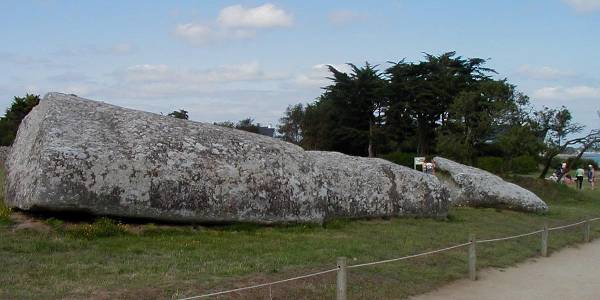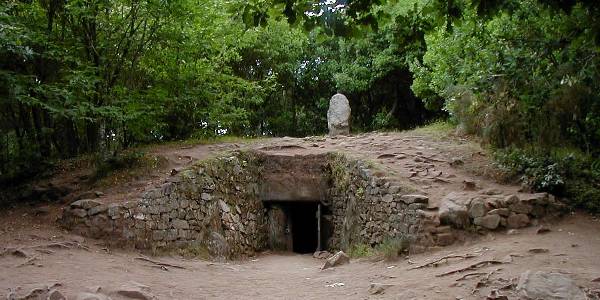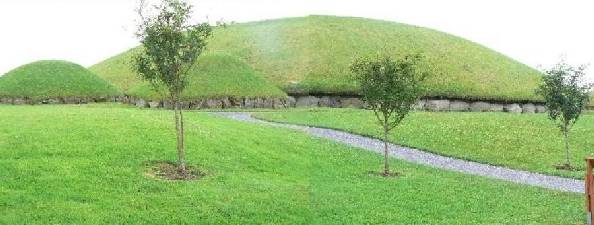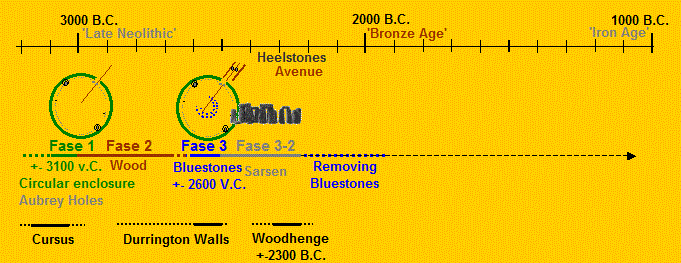Page content - Navigation bar - Next
page - Previous page - Index ABC (EN)
- Intro-EN
- NL ![]()

Intro-EN

Megaliths: Age
Celtic druids are often wrongly seen as builders of megalithic monuments.

Age determination
The age of megalithic monuments, build in natural stones,
can not be determinate directly. Researchers can only use carbon dating on
remains found in or near the monuments. But those remains can be more recent
than the monument self...
Most megaliths are probably set up between 5000 en 1500
B.C. But lot of contradiction exist, some monument's dating
are different according to different authors.
Age of standing stones
Accepted is that many standing stones are dated very early, the biggest are the oldest. The "Big Broken Standing Stone" in Locmariaquer (+- 20 meter) is estimated to be set up around 4500 B.C.

Big Broken Standing Stone (Grand Menhir Brisť) - Locmariaquer, Bretagne-France
Age grave-mounds
The first grave-mounds, the long barrows, had no stones inside. The long barrow of Lambourn (G.B.) is dated +- 4300 B.C.
The passage tomb "Table des Marchands" (Locmariaquer -
Bretagne), one of the oldest stone buildings in Europe, is dated around 3900
B.C.
The "Tumulus de Kercado" (+-3800 B.C.), situated near
the 'alignments' in Carnac is possibly much older. Some sources* give the date
4800 B.C. for Kercado.
(* 'Mensen in de steentijd' - Uitg. Kosmos, 1994)

Kercado-tumulus, Carnac
Newgrange, Knowth and Dowth, de best known 'grave-mounds' in Ireland where built around 3200 B.C.

Knowth, a big 'grave-mound' encircled by smaller tombs
Age stone circles
The big stone circle in Avebury (G.B.) was erected probably
around 3100 B.C.
Smaller stone circles mostly originate from the Bronze Age (after 2000 B.C.).
Stonehenge was constructed in different fazes.
The oldest Stonehenge (+- 3100 B.C.) included a circular ditch with inside a
mysterious ring of 'postholes', the so-called "Aubrey-holes"
Around 2160 B.C. a double circle of "Blue Stones" was set up inside the
enclosure.
The famous big 'Sarsen Stones' where placed between 2600
and 2500 B.C. "Sarsen-Stonehenge" probably was the last big megalithic
construction. Until +- 1550 B.C. some 'things' where changed around the
construction.
In comparison: The Big Cheops Pyramid (Egypt) was probably built around 2550 B.C.

 The dates of the arrival of the Bleu Stones and the construction of Sarsen-Stones
given above are the results of recent investigations by Prof. Mike Parker Pearson
and his team, older sources give younger dates.
The dates of the arrival of the Bleu Stones and the construction of Sarsen-Stones
given above are the results of recent investigations by Prof. Mike Parker Pearson
and his team, older sources give younger dates.
'Back to top' - Function (= Next page)